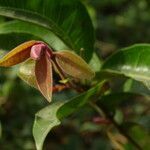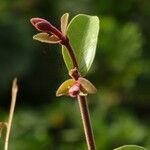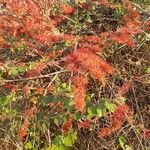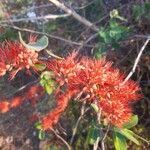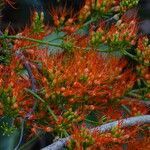It is usually a vigorous climber or scrambling bush. It can be a small tree 3-4 m high. The bark is grey to pale brown. The leaves are opposite and oval. They are 18 cm long by 9.5 cm wide. They are thinly leathery. They are glossy dark green but paler underneath. The veins are yellow and like a net. The base has shallow lobes. The leaf stalk is 3 cm long. The flowers are bright red with very red stamens. The petals are 2.5 mm across. The flowers are in small clusters but the large number along the stem create a showy display. The fruit are 4 winged. They are 2 cm across. They are pink or red when young and dry to a pale brown.
Lower receptacle up to 4(5) mm. long, usually somewhat constricted above and below the ovary, densely fulvous-or rufous-(more rarely silvery-)pubescent; upper receptacle 4–5 x 2–3 mm. (in our area), campanulate, densely fulvous-or rufous-(or more rarely silvery-) pubescent, sometimes nearly glabrous towards the apex.
Leaves opposite; lamina up to 12(18) x 8(9·5) cm., usually c. 1 1/2 times as long as broad, chartaceous, oblong-elliptic, usually glabrous or nearly so, apex rounded or acuminate, base obtuse to subcordate; lateral nerves 4–6(8) pairs; petiole up to 3 cm. long, the base often persistent and becoming spiny.
Usually a vigorous evergreen climber or a scrambling shrub in absence of support (occasionally a bush—perhaps intermediates or hybrids with C. platypetalum); bark grey to grey-black; branchlets usually rufous-tomentose at first but soon glabrescent.
Fruit 4(5)-winged, 2–2·5 x 1·5–2 cm. (in our area, sometimes larger elsewhere), subcircular to oblong-elliptic in outline, sparsely pubescent on the body, apical peg usually absent, wings up to 9 mm. broad, thin, stipe 5–10 mm. long.
Inflorescences terminal or axillary panicles; rhachis usually fuscous-or fulvous-tomentose; bracts c. 4 mm. long, very narrowly ovate-elliptic.
Petals red, c. 2·5 x 2·5 mm., subcircular to ovate, usually somewhat overlapping at first and ± connivent.
Scandent to scrambling shrub or robust liane with bright red flowers. Description pending.
Stamen-filaments 7–8 mm. long, usually red; anthers 0·9 mm. long, red or purplish.
Petals and stamens bright red; flowers often produced when plant is leafless.
Flowers red, 4(5)-merous, sessile or very shortly pedicellate.
Sepals usually reduced to short teeth, sometimes triangular.
Disk rather inconspicuous, without a free margin.
Scandent shrub, becoming lofty liane in forest
Petioles becoming spines
Style 6–8 mm. long.
